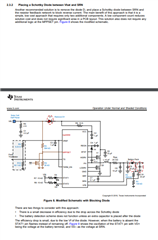Tool/software:
I am looking for help with a problem related to a PCBA with a BQ24650 charger for a 12V lead acid battery.
The used solar panel is a 3W 18V type, so the MPPT point is also set to 18V. When shortcircuited the panel delivers its rated current.
When I use a power supply at 19V with 1A current limiting, it pulls 1A current and PSU voltage drops to 18V like it's supposed to.
Now when I use the actual solar panel it seems to be stable at lower currents (<50mA) but starts to hiccup at anything higher. STAT1 led is blinking.
The solar panel voltage seems to be stable at 18V, or even seem to jump up a bit (indicating charger disconnection).
Here is the schematic:

And the associated layout: (4 layer, copper pour removed for visibility)


Some suspicions:
- Could it be due to charger termination setting somehow?
- Could it be due to the higher charge current? It's set to 2A in case a PSU is used, but solar panel is only 160mA max. Could this cause issues?
- I have put the resistor feedback network before the diode and compensated the forward voltage. Maybe this messes with the feedback loop?
- Something else?
Thanks in advance,
Jesse van der Zouw


